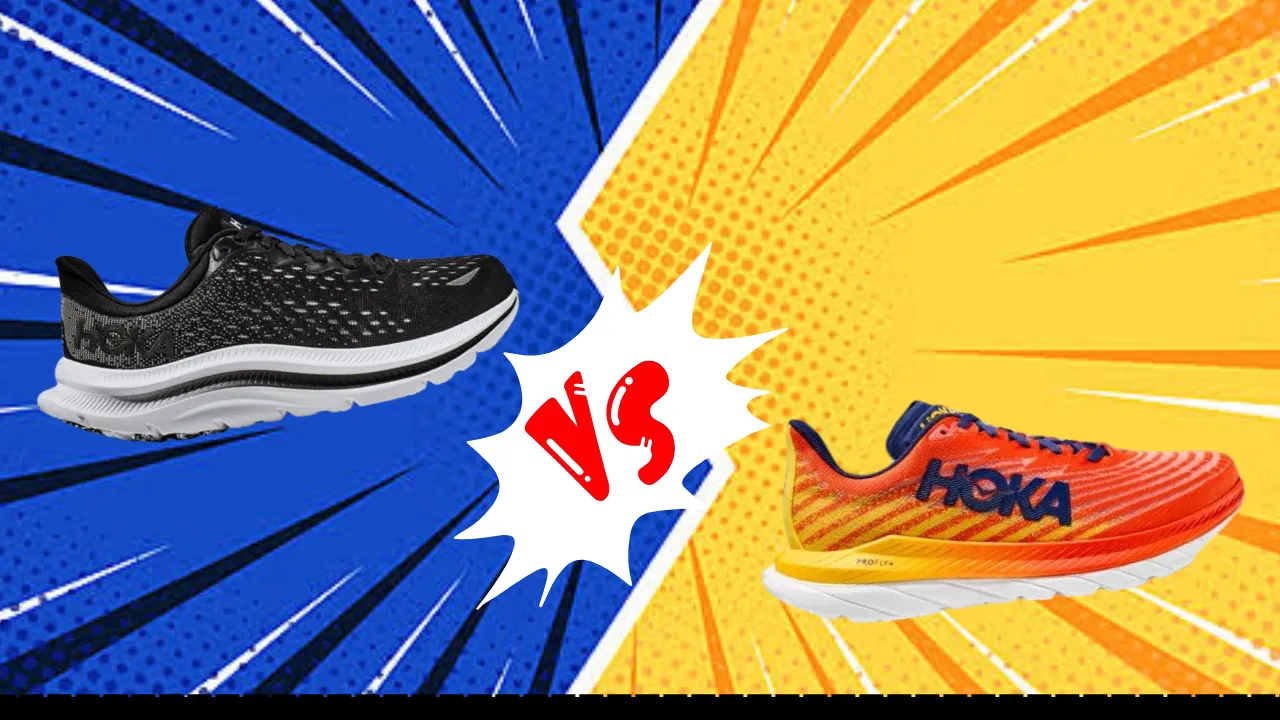Looking for a versatile running shoe that can handle everything from short training runs to long distances? The Hoka Kawana and Mach 5 are two of the latest lightweight trainers from Hoka One One.
Both shoes provide responsive cushioning and comfort, but there are some key differences that may make one model a better fit for your running needs. Read on for a detailed comparison of these two popular Hoka shoes.
Similarities And Differences Between Hoka Kawana and Hoka Mach 5:
| Feature | Hoka Kawana | Hoka Mach 5 |
|---|---|---|
| Launched In | 2022 | 2022 |
| Stability | Moderate | Neutral |
| Flexibility | Moderate | Moderate |
| Sizing | Men’s 7-13, Women’s 5-11 | Men’s 7-13, Women’s 5-11 |
| Weight | 10.5 oz (M), 9.2 oz (W) | 7.6 oz (M), 6.8 oz (W) |
| Cushioning | CMEVA foam | Profly foam |
| Outsole | Full rubber coverage | Rubberized foam |
| Midsole | CMEVA foam | Profly foam |
| Upper | Engineered mesh | Engineered mesh |
| Retail Price | $140 | $140 |
Features Comparison:
MATERIALS
The Hoka Kawana uses a combination of CMEVA foam in the midsole and outsole along with an engineered mesh upper. The midsole foam provides responsive cushioning while being durable and supportive. The full rubber outsole offers excellent traction on varied surfaces.


The Mach 5 utilizes Profly foam in the midsole, which is softer and bouncier than the CMEVA foam. The outsole uses a rubberized foam that is lightweight but less durable. The upper is also an engineered mesh that is highly breathable.
DURABILITY
The Kawana wins when it comes to durability thanks to its full rubber outsole and sturdy CMEVA foam midsole. The outsole provides good traction even after miles of wear.
The Mach 5’s rubberized foam outsole starts showing signs of wear much sooner. The lightweight foam just doesn’t have the same resilience as the Kawana’s rubber coverage. The Mach 5’s upper is also less sturdy than the structured mesh of the Kawana.
FIT
The Kawana runs true to size for most runners, but some may find the forefoot area too narrow. The structured mesh upper wraps the foot securely.


The Mach 5 has a more forgiving engineered mesh upper with a broader forefoot fit. It accommodates wider feet better than the Kawana. The rest of the shoe fits true to size.
STABILITY
The Kawana provides moderate stability features, making it suitable for neutral runners who need a little extra support. The wide platform, foam sidewalls, and structured upper provide a stable feel.
The Mach 5 has a neutral design without added stability elements. The flexible foam and mesh upper allow for natural foot movement but don’t prevent overpronation on their own.
CUSHIONING
The Kawana offers a firm yet responsive cushioned ride. The CMEVA foam midsole and rockered geometry provide soft landings without feeling too squishy.
The Mach 5 delivers very soft, bouncy cushioning from the Profly foam. Testers found the energetic midsole to be lively and comfortable even on longer runs.
VALUE
The Kawana has a moderate $140 price tag that reflects the durable materials and versatile performance. Runners get a lot of value from this everyday trainer.
The Mach 5 costs $140, making it a well-priced option for a lightweight, responsive shoe. The value is excellent if you aren’t deterred by the shorter outsole lifespan.
Performance Comparison:
FOR WALKING
The Kawana’s cushioned yet stable midsole makes it a good choice for walking. The moderate heel-toe drop encourages a natural stride while the foam provides shock absorption. The grippy outsole also handles varied walking surfaces well.
The Mach 5 has a soft midsole that feels somewhat unstable for longer walks. The heel lacks structure and the flexible forefoot doesn’t provide much leverage for an efficient walking gait cycle.
FOR RUNNING
As versatile trainers, both the Kawana and Mach 5 perform well for road running. The Kawana provides responsive cushioning and stability for daily miles while the Mach 5 offers very soft landings. The Mach 5 would better suit forefoot strikers or runners looking for energy return.
FOR PLANTAR FASCIITIS
The Kawana’s structured cushioning and stability features make it a good choice if you have plantar fasciitis or overpronation issues. The arch support and firm heel counter provide relief by minimizing strain on the plantar fascia.
The Mach 5 lacks the specific elements needed to prevent overpronation and manage plantar fasciitis. The very soft foam may also exacerbate pain by compressing too much.
FOR STANDING ALL DAY
The Kawana’s ample cushioning and supportive frame make it well-suited for all-day wear. The structured upper keeps the foot in place while the foam midsole absorbs shock. The rocker shape encourages natural foot motion as well.
The Mach 5 doesn’t have the same stability and structure for prolonged standing. The soft foam compresses excessively, and the mesh upper stretches out over time. There just isn’t enough support built in.
FINAL VERDICT:
The Hoka Kawana is the better choice if you want a durable, supportive trainer that can handle walking, gym workouts, and medium to long-distance running. Its versatile performance makes it suitable for runners with plantar fasciitis or who are on their feet all day.
The Mach 5 is ideal for runners who want soft, lively cushioning for shorter distances and speed work. The breathable upper and energetic ride make it best for neutral runners with narrow to average-width feet. Keep in mind that Mach 5 loses its peppiness faster than the resilient Kawana.
Analyze your running needs and foot type to decide which of these Hokas will give you the most miles of comfortable wear. Both are great additions to a runner’s rotation when used for the right purposes.

